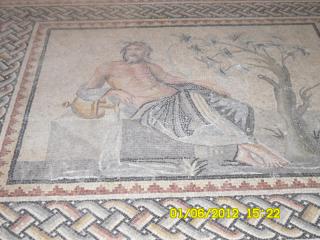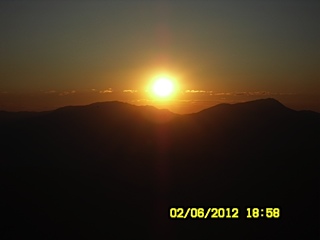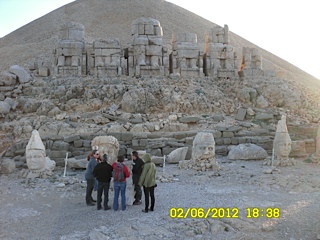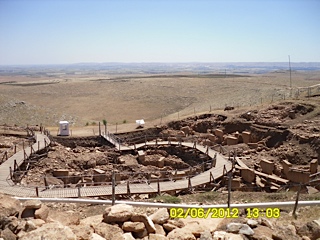When you travel east from Bodrum, you realise that Turkey is more a continent than a country. The landscape is more immense: vast open plains with nomadic flocks of sheep, towns enclosed by massive basalt walls, and Mount Ağrı, supposedly the Biblical Ararat on which Noah’s Ark came to rest, looming above Doğubayazıt.
Tour to south-eastern Turkey 1 to 4 June 2012
When you travel east from Bodrum, you realise that Turkey is more a continent than a country. The landscape is more immense: vast open plains with nomadic flocks of sheep, towns enclosed by massive basalt walls, and Mount Ağrı, supposedly the Biblical Ararat on which Noah’s Ark came to rest, looming above Doğubayazıt.
In fact, everything in this landscape seems to be on an immense scale. Superlatives abound in connection with places of interest. Lake Van, the largest lake in Turkey which can take up to six hours to cross by ferry boat, Diyabakır, allegedly the hottest place in Turkey in the summer, and Mount Agrı, at over 5,000m the highest mountain in the country. Perhaps it was this larger than life quality about the region that persuaded Antiochus I of Commagene to erect the colossal statues at the summit of Mount Nemrut or, more likely, his larger than life ego. Whichever it was, the toppled heads now litter the ground, taller than the visitors who make the trip up the mountain to see them.
This immensity of scale in the region is also reflected in the distances travellers have to cover between major cities and areas of interest. A journey that may not look far on the map may take almost a day to cover because the distance involved is so vast and because the roads in the region are less good than in the more developed areas.
So it was that 28 members and friends of Herodotus Third Age Academy set off from Bodrum on Friday 1 June, flying from Izmir to Gaziantep to start a four day wonderful, exhausting, educational, enlightening and memorable trip to south-eastern Turkey.
Day one Friday 1 June
Depart 10:00 Izmir by Sunexpres direct flight to Gaziantep
Arrive Gaziantep 11:40
Visit Zeugma Mosaics Museum and old town markets. Taste famous local food at lunch and dinner
Gaziantep is a prosperous town of Hittite origin and the centre of the pistachio nut industry. Known in Ottoman times as Antab (pistachio), the city acquired a mark of distinction (Gazi War Hero) as a result of the heroism displayed by its citizens during the Turkish War of Independence (1920 to 1922) when they held off the French during a ten month siege.
We arrived at noon and had a look around the old town markets selling fruit and vegetables and with the smell of barbecuing permeating the streets. We visited a typical house where we saw glass beads and silver jewellery being made without tools other than a flame gun. It was fascinating to see how those pretty things we wear are made. We stopped to pick a few pistachio nuts ‘not quite ripe and were left with sticky fingers, smelling like pine oil’.
After lunch we visited the largest mosaic museum in the world with mosaics saved from the city of Zeugma, now submerged by the Birecik dam. The excavations and relocation of these cost $6 million, of which $5 million was contributed by Hewlett Packard. The many beautiful mosaics, almost complete, include the Gypsy Girl which is kept in a dark room with an armed guard. There are also some fine frescoes and the impressive bronze statue of the god of war, Mars.
Day two Saturday 2 June
Visit Halfeti, Ataturk Dam boat trip, biblical city of Edessa (Urfa) including the pool and shrine of Abraham. On to Gobekli Tepe, bus trip to top of Mount Nemrut, visiting east, west and north terraces of the archeological sites and watch the sunset from the summit.
Overnight at Bozdogan Hotel in Kahta
Day two started with a visit to the bird sanctuary at Birecik, about 46 km east of Gaziantep, right by the Euphrates River. Birecik is one of the few nesting places in the world of the eastern Bald Ibis, a bird species that hovers on the brink of extinction. The world population of this bird was once reduced to eleven but, thanks to the sanctuary, it is now 26 and rising. On then to Halfeti which is half-submerged by the flooding of the Birecik dam on the River Euphrates. During our 45 minute boat trip we saw nothing of the submerged part of the village except the minaret rising strangely out of the water.
Moving away from the Euphrates, we had a long drive to Şanlıufa passing within 30km of the Syrian border. After a quick lunch we had an even quicker peep at the peaceful Pool of Abraham filled with sacred carp before getting back on the bus for the long drive to Kahta.
On the way we visited Gobekli Tepe (Pot Belly Hill), the site of 11,600 year old temples, the oldest in the world. The circular chambers contain a series of T-shaped monoliths, the tallest of which are 5m high. Many are liberally adorned with relief carvings of wild animals. No indication here of a settlement. Man was still in the hunter-gatherer stage of development, yet they were capable of producing monumental buildings and sophisticated art.
We dumped our luggage at the hotel and an hour later we were at Mount Nemrut. This awe-inspiring peak rises to a height of 215m in the Anti-Taurus range between the provincial capital of Malatya to the north and Kahta in Adıyaman province to the south.
Nobody knew anything about Mount Nemrut until 1881, when a German engineer, employed by the Ottomans to assess transport routes, was astounded to come across the statues covering this remote mountain-top. The summit was created when a megalomaniac pre-Roman local king, Antiochus 1 Epiphanes (64 – 38 BC) cut two ledges in the rock, filled them with colossal statues of himself and the gods Fortuna, Zeus, Apollo and Hercules, then ordered an artificial mountain peak of crushed rock 50m high to be piled between them. Erosion, storms and earthquakes have toppled the heads from most of the statues.
We had been warned but not all were prepared for how cold and windy it was. We trudged up a long and winding stone and rubble path to the summit. One of our party took the donkey taxi, a good idea. Hundreds of photos, a memorable sunset and a glass of wine later, we set off back down the mountain.
Day three Sunday 3 June
Visit Hasankeyf, Mor Gabriel Monastery in Midyat, old markets in Midyat, dinner at the famous Mahsun Usta restaurant in Mardin
Another early start, leaving the hotel at 07:30 for the long drive, via Diyarbakır, to Hasankeyf – a 5000 year old village on the River Tigris. As part of the Southeastern Anatolia Project (GAP) another dam will be built and the area will be flooded. Unpopular with historians, GAP has dramatically improved the fertility of the area and thus the lot of farmers and herdsmen. The building of a new village is already under way on the opposite hill. We strolled, shopped and took some tea. Many lamented the future flooding of this ancient settlement but power and water are needed for the area.
We had now travelled across Mesopotamia, the plain that stretches between the two rivers, Euphrates and Tigris, and we were on our way to Mardin and Midyat. About twenty kms east of Midyat is the Mor Gabriel monastery which rises like a mirage from its desert-like surroundings. Founded in 397AD, it is the oldest and most vital surviving Syrian Orthodox monastery in Turkey. Recent restoration, funded by wealthy US and UK emigres, has left a strikingly beautiful building inhabited by nuns, monks, lay workers and students. We were given a guided tour by a lay worker, ably translated by our guide. (Members of the H3A English reading group will recall William Dalrymple’s description when they read From the Holy Mountain in 2011. See the write up on the H3A website.)
Next stop was Mardin where the population is a mix of Kurds, Arabs, Turks and Syrian Orthodox Christians (Suriyani). It has its old part, quaint and atmospheric and its new part, not so pretty. We stayed in the charming Artuklu Karavansaray made from a restored caravanserai dating back to the 13th century with authentic rooms decorated in old Turkish style full of artefacts. That evening we had an excellent dinner at the Mahsun Usta restaurant and spent the night in a hotel in Mardin’s old town with a breathtaking view of the Mesopotamian plain.
Day four Monday 4 June
Visit Dara antique city, Deyrul Zafaran monastery, Mardin’s old city areas and Mardin Museum
Depart 12:10 Pegasus direct flight to İzmir. Transfer to Bodrum.
Our final day started again at 07:30 with a drive to Dara named after King Darius where the Byzantine ruins are set amidst the houses of a traditional Kurdish village. The remains are extensive and some of us climbed down into the bowels of the earth to visit the huge underground water depot, thirty metres high. It was well-lit, awe-inspiring and wonderfully cool. Off then to the monastery of Deyr-as-Zaferan or Saffron Monastery where we drank saffron tea before being shown around.
Lovingly restored but not quite as pristine as Mor Gabriel, it had an aura of serenity, beauty and peace. Founded in 493 AD, it was the seat of the Syrian Orthodox patriarch until the 1920s, since relocated to Damascus.
Now it was time to go to the airport for our return flight from Mardin to Izmir
Thanks to Linda Bennett and Cheryl Sabey
In fact, everything in this landscape seems to be on an immense scale. Superlatives abound in connection with places of interest. Lake Van, the largest lake in Turkey which can take up to six hours to cross by ferry boat, Diyabakır, allegedly the hottest place in Turkey in the summer, and Mount Agrı, at over 5,000m the highest mountain in the country. Perhaps it was this larger than life quality about the region that persuaded Antiochus I of Commagene to erect the colossal statues at the summit of Mount Nemrut or, more likely, his larger than life ego. Whichever it was, the toppled heads now litter the ground, taller than the visitors who make the trip up the mountain to see them.
This immensity of scale in the region is also reflected in the distances travellers have to cover between major cities and areas of interest. A journey that may not look far on the map may take almost a day to cover because the distance involved is so vast and because the roads in the region are less good than in the more developed areas.
So it was that 28 members and friends of Herodotus Third Age Academy set off from Bodrum on Friday 1 June, flying from Izmir to Gaziantep to start a four day wonderful, exhausting, educational, enlightening and memorable trip to south-eastern Turkey.
Day one Friday 1 June
Depart 10:00 Izmir by Sunexpres direct flight to Gaziantep
Arrive Gaziantep 11:40
Visit Zeugma Mosaics Museum and old town markets. Taste famous local food at lunch and dinner
Gaziantep is a prosperous town of Hittite origin and the centre of the pistachio nut industry. Known in Ottoman times as Antab (pistachio), the city acquired a mark of distinction (Gazi War Hero) as a result of the heroism displayed by its citizens during the Turkish War of Independence (1920 to 1922) when they held off the French during a ten month siege.
We arrived at noon and had a look around the old town markets selling fruit and vegetables and with the smell of barbecuing permeating the streets. We visited a typical house where we saw glass beads and silver jewellery being made without tools other than a flame gun. It was fascinating to see how those pretty things we wear are made. We stopped to pick a few pistachio nuts ‘not quite ripe and were left with sticky fingers, smelling like pine oil’.
After lunch we visited the largest mosaic museum in the world with mosaics saved from the city of Zeugma, now submerged by the Birecik dam. The excavations and relocation of these cost $6 million, of which $5 million was contributed by Hewlett Packard. The many beautiful mosaics, almost complete, include the Gypsy Girl which is kept in a dark room with an armed guard. There are also some fine frescoes and the impressive bronze statue of the god of war, Mars.
Day two Saturday 2 June
Visit Halfeti, Ataturk Dam boat trip, biblical city of Edessa (Urfa) including the pool and shrine of Abraham. On to Gobekli Tepe, bus trip to top of Mount Nemrut, visiting east, west and north terraces of the archeological sites and watch the sunset from the summit.
Overnight at Bozdogan Hotel in Kahta
Day two started with a visit to the bird sanctuary at Birecik, about 46 km east of Gaziantep, right by the Euphrates River. Birecik is one of the few nesting places in the world of the eastern Bald Ibis, a bird species that hovers on the brink of extinction. The world population of this bird was once reduced to eleven but, thanks to the sanctuary, it is now 26 and rising. On then to Halfeti which is half-submerged by the flooding of the Birecik dam on the River Euphrates. During our 45 minute boat trip we saw nothing of the submerged part of the village except the minaret rising strangely out of the water.
Moving away from the Euphrates, we had a long drive to Şanlıufa passing within 30km of the Syrian border. After a quick lunch we had an even quicker peep at the peaceful Pool of Abraham filled with sacred carp before getting back on the bus for the long drive to Kahta.
On the way we visited Gobekli Tepe (Pot Belly Hill), the site of 11,600 year old temples, the oldest in the world. The circular chambers contain a series of T-shaped monoliths, the tallest of which are 5m high. Many are liberally adorned with relief carvings of wild animals. No indication here of a settlement. Man was still in the hunter-gatherer stage of development, yet they were capable of producing monumental buildings and sophisticated art.
We dumped our luggage at the hotel and an hour later we were at Mount Nemrut. This awe-inspiring peak rises to a height of 215m in the Anti-Taurus range between the provincial capital of Malatya to the north and Kahta in Adıyaman province to the south.
Nobody knew anything about Mount Nemrut until 1881, when a German engineer, employed by the Ottomans to assess transport routes, was astounded to come across the statues covering this remote mountain-top. The summit was created when a megalomaniac pre-Roman local king, Antiochus 1 Epiphanes (64 – 38 BC) cut two ledges in the rock, filled them with colossal statues of himself and the gods Fortuna, Zeus, Apollo and Hercules, then ordered an artificial mountain peak of crushed rock 50m high to be piled between them. Erosion, storms and earthquakes have toppled the heads from most of the statues.
We had been warned but not all were prepared for how cold and windy it was. We trudged up a long and winding stone and rubble path to the summit. One of our party took the donkey taxi, a good idea. Hundreds of photos, a memorable sunset and a glass of wine later, we set off back down the mountain.
Day three Sunday 3 June
Visit Hasankeyf, Mor Gabriel Monastery in Midyat, old markets in Midyat, dinner at the famous Mahsun Usta restaurant in Mardin
Another early start, leaving the hotel at 07:30 for the long drive, via Diyarbakır, to Hasankeyf – a 5000 year old village on the River Tigris. As part of the Southeastern Anatolia Project (GAP) another dam will be built and the area will be flooded. Unpopular with historians, GAP has dramatically improved the fertility of the area and thus the lot of farmers and herdsmen. The building of a new village is already under way on the opposite hill. We strolled, shopped and took some tea. Many lamented the future flooding of this ancient settlement but power and water are needed for the area.
We had now travelled across Mesopotamia, the plain that stretches between the two rivers, Euphrates and Tigris, and we were on our way to Mardin and Midyat. About twenty kms east of Midyat is the Mor Gabriel monastery which rises like a mirage from its desert-like surroundings. Founded in 397AD, it is the oldest and most vital surviving Syrian Orthodox monastery in Turkey. Recent restoration, funded by wealthy US and UK emigres, has left a strikingly beautiful building inhabited by nuns, monks, lay workers and students. We were given a guided tour by a lay worker, ably translated by our guide. (Members of the H3A English reading group will recall William Dalrymple’s description when they read From the Holy Mountain in 2011. See the write up on the H3A website.)
Next stop was Mardin where the population is a mix of Kurds, Arabs, Turks and Syrian Orthodox Christians (Suriyani). It has its old part, quaint and atmospheric and its new part, not so pretty. We stayed in the charming Artuklu Karavansaray made from a restored caravanserai dating back to the 13th century with authentic rooms decorated in old Turkish style full of artefacts. That evening we had an excellent dinner at the Mahsun Usta restaurant and spent the night in a hotel in Mardin’s old town with a breathtaking view of the Mesopotamian plain.
Day four Monday 4 June
Visit Dara antique city, Deyrul Zafaran monastery, Mardin’s old city areas and Mardin Museum
Depart 12:10 Pegasus direct flight to İzmir. Transfer to Bodrum.
Our final day started again at 07:30 with a drive to Dara named after King Darius where the Byzantine ruins are set amidst the houses of a traditional Kurdish village. The remains are extensive and some of us climbed down into the bowels of the earth to visit the huge underground water depot, thirty metres high. It was well-lit, awe-inspiring and wonderfully cool. Off then to the monastery of Deyr-as-Zaferan or Saffron Monastery where we drank saffron tea before being shown around.
Lovingly restored but not quite as pristine as Mor Gabriel, it had an aura of serenity, beauty and peace. Founded in 493 AD, it was the seat of the Syrian Orthodox patriarch until the 1920s, since relocated to Damascus.
Now it was time to go to the airport for our return flight from Mardin to Izmir
Thanks to Linda Bennett and Cheryl Sabey








